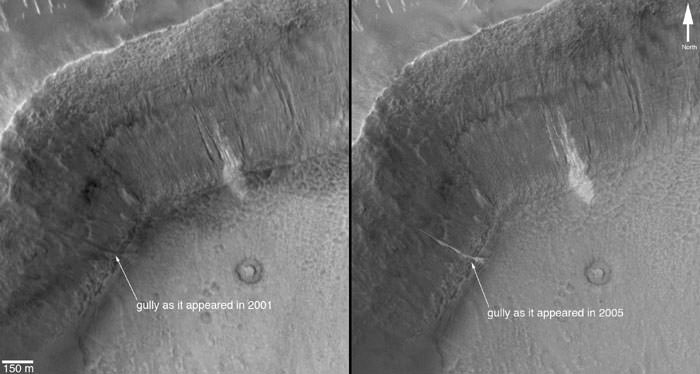Thanks to the team from the HiRISE camera on board the Mars Reconnaissance Orbiter, we can enjoy these great wintery-looking views of the Red Planet.
Curiosity Starts First Science on Mars Sojurn – How Lethal is Space Radiation to Life’s Survival
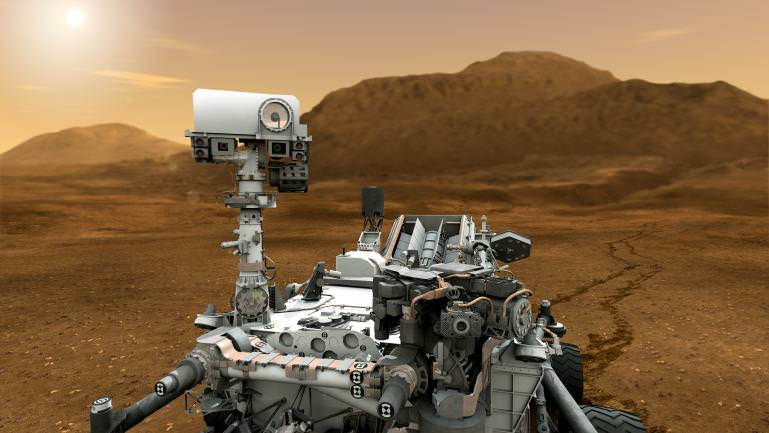
[/caption]
Barely two weeks into the 8 month journey to the Red Planet, NASA’s Curiosity Mars Science Lab (MSL) rover was commanded to already begin collecting the first science of the mission by measuring the ever present radiation environment in space.
Engineers powered up the MSL Radiation Assessment Detector (RAD) that monitors high-energy atomic and subatomic particles from the sun, distant supernovas and other sources.
RAD is the only one of the car-sized Curiosity’s 10 science instrument that will operate both in space as well as on the Martian surface. It will provide key data that will enable a realistic assessment of the levels of lethal radiation that would confront any potential life forms on Mars as well as Astronauts voyaging between our solar systems planets.
“RAD is the first instrument on Curiosity to be turned on. It will operate throughout the long journey to Mars,” said Don Hassler, RAD’s principal investigator from the Southwest Research Institute in Boulder, Colo.
These initial radiation measurements are focused on illuminating possible health effects facing future human crews residing inside spaceships.
Video Caption: The Radiation Assessment Detector is the first instrument on Curiosity to begin science operations. It was powered up and began collecting data on Dec. 6, 2011. Credit: NASA
“We want to characterize the radiation environment inside the spacecraft because it’s different from the radiation environment measured in interplanetary space,” says Hassler.
RAD is located on the rover which is currently encapsulated within the protective aeroshell. Therefore the instrument is positioned inside the spacecraft, simulating what it would be like for an astronaut with some shielding from the external radiation, measuring energetic particles.
“The radiation hitting the spacecraft is modified by the spacecraft, it gets changed and produces secondary particles. Sometimes those secondary particles can be more damaging than the primary radiation itself.”
“What’s new is that RAD will measure the radiation inside the spacecraft, which will be very similar to the environment that a future astronaut might see on a future mission to Mars.”
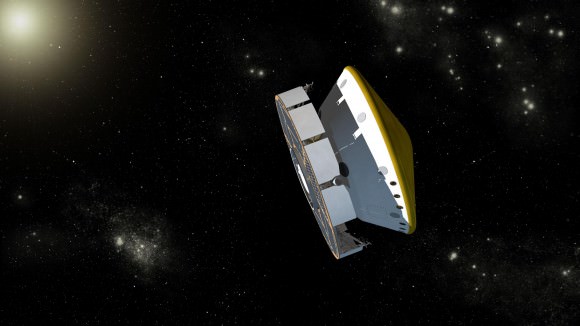
Curiosity’s purpose is to search for the ingredients of life and assess whether the rovers landing site at Gale Crater could be or has been favorable for microbial life.
The Martian surface is constantly bombarded by deadly radiation from space. Radiation can destroy the very organic molecules which Curiosity seeks.
“After Curiosity lands, we’ll be taking radiation measurements on the surface of another planet for the first time,” notes Hassler.
RAD was built by a collaboration of the Southwest Research Institute, together with Christian Albrechts University in Kiel, Germany with funding from NASA’s Human Exploration Directorate and Germany’s national aerospace research center, Deutsches Zentrum für Luft- und Raumfahrt.
“What Curiosity might find could be a game-changer about the origin and evolution of life on Earth and elsewhere in the universe,” said Doug McCuistion, director of the Mars Exploration Program at NASA Headquarters in Washington. “One thing is certain: The rover’s discoveries will provide critical data that will impact human and robotic planning and research for decades.”
Curiosity was launched from Florida on Nov. 26. After sailing on a 254 day and 352-million-mile (567-million-kilometer) interplanetary flight from the Earth to Mars, Curiosity will smash into the atmosphere at 13,000 MPH on August 6, 2012 and pioneer a nail biting and first-of-its-kind precision rocket powered descent system to touchdown inside layered terrain at Gale Crater astride a 3 mile (5 km) high mountain that may have preserved evidence of ancient or extant Martian life.
Miraculously, NASA’s Opportunity Mars rover and onboard instruments and cameras have managed to survive nearly 8 years of brutally harsh Martian radiation and arctic winters.
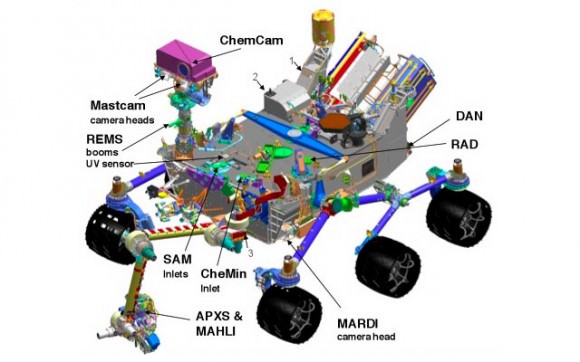
Complete Coverage of Curiosity – NASA’s Next Mars Rover launched 26 Nov. 2011
Read continuing features about Curiosity by Ken Kremer starting here:
Flawlessly On Course Curiosity Cruising to Mars – No Burn Needed Now
NASA Planetary Science Trio Honored as ‘Best of What’s New’ in 2011- Curiosity/Dawn/MESSENGER
Curiosity Mars Rover Launch Gallery – Photos and Videos
Curiosity Majestically Blasts off on ‘Mars Trek’ to ascertain ‘Are We Alone?
Mars Trek – Curiosity Poised to Search for Signs of Life
Curiosity Rover ‘Locked and Loaded’ for Quantum Leap in Pursuit of Martian Microbial Life
Science Rich Gale Crater and NASA’s Curiosity Mars Rover in Glorious 3-D – Touchdown in a Habitable Zone
Curiosity Powered Up for Martian Voyage on Nov. 26 – Exclusive Message from Chief Engineer Rob Manning
NASA’s Curiosity Set to Search for Signs of Martian Life
Curiosity Rover Bolted to Atlas Rocket – In Search of Martian Microbial Habitats
Closing the Clamshell on a Martian Curiosity
Curiosity Buttoned Up for Martian Voyage in Search of Life’s Ingredients
Assembling Curiosity’s Rocket to Mars
Encapsulating Curiosity for Martian Flight Test
Dramatic New NASA Animation Depicts Next Mars Rover in Action
New Study Says Large Regions of Mars Could Sustain Life
[/caption]
The question of whether present-day Mars could be habitable, and to what extent, has been the focus of long-running and intense debates. The surface, comparable to the dry valleys of Antarctica and the Atacama desert on Earth, is harsh, with well-below freezing temperatures most of the time (at an average of minus 63 degrees Celsius or minus 81 Fahrenheit), extreme dryness and a very thin atmosphere offering little protection from the Sun’s ultraviolet radiation. Most scientists would agree that the best place that any organisms could hope to survive and flourish would be underground. Now, a new study says that scenario is not only correct, but that large regions of Mars’ subsurface could be even more sustainable for life than previously thought.
Scientists from the Australian National University modeled conditions on Mars on a global scale and found that large regions could be capable of sustaining life – three percent of the planet actually, albeit mostly underground. By comparison, just one percent of Earth’s volume, from the central core to the upper atmosphere, is inhabited by some kind of life. They compared pressure and temperature conditions on Earth to those of Mars to come up with the surprising results.
According to Charley Lineweaver of ANU, “What we tried to do, simply, was take almost all of the information we could and put it together and say ‘is the big picture consistent with there being life on Mars?’ And the simple answer is yes… There are large regions of Mars that are compatible with terrestrial life.”
So it seems that while, as we know, the surface of Mars is quite inhospitable to most forms of life (that we know of) except perhaps for some extremophiles, conditions underground are a different matter. It is already known that there are vast deposits of ice below the surface even near the equator (as well as the polar ice caps of course), so there could be liquid water a bit deeper where it is warmer. Those conditions would be ideal for bacteria or other simple organisms. While that idea has been proposed and discussed before, Lineweaver’s findings support it on a planet-wide basis – previous studies tended to focus on specific locations in a “piecemeal” approach, but these new ones take the entire planet into consideration.
The paper is currently available for free here. Abstract:
We present a comprehensive model of martian pressure-temperature (P-T) phase space and compare it with that of Earth. Martian P-T conditions compatible with liquid water extend to a depth of *310 km. We use our phase space model of Mars and of terrestrial life to estimate the depths and extent of the water on Mars that is habitable for terrestrial life. We find an extensive overlap between inhabited terrestrial phase space and martian phase space. The lower martian surface temperatures and shallower martian geotherm suggest that, if there is a hot deep biosphere on Mars, it could extend 7 times deeper than the *5km depth of the hot deep terrestrial biosphere in the crust inhabited by hyperthermophilic chemolithotrophs. This corresponds to *3.2% of the volume of present-day Mars being potentially habitable for terrestrial-like life. Key Words: Biosphere—Mars— Limits of life—Extremophiles—Water. Astrobiology 11, xxx–xxx.
Dawn swoops to lowest orbit around Vesta – Unveiling Spectacular Alien World
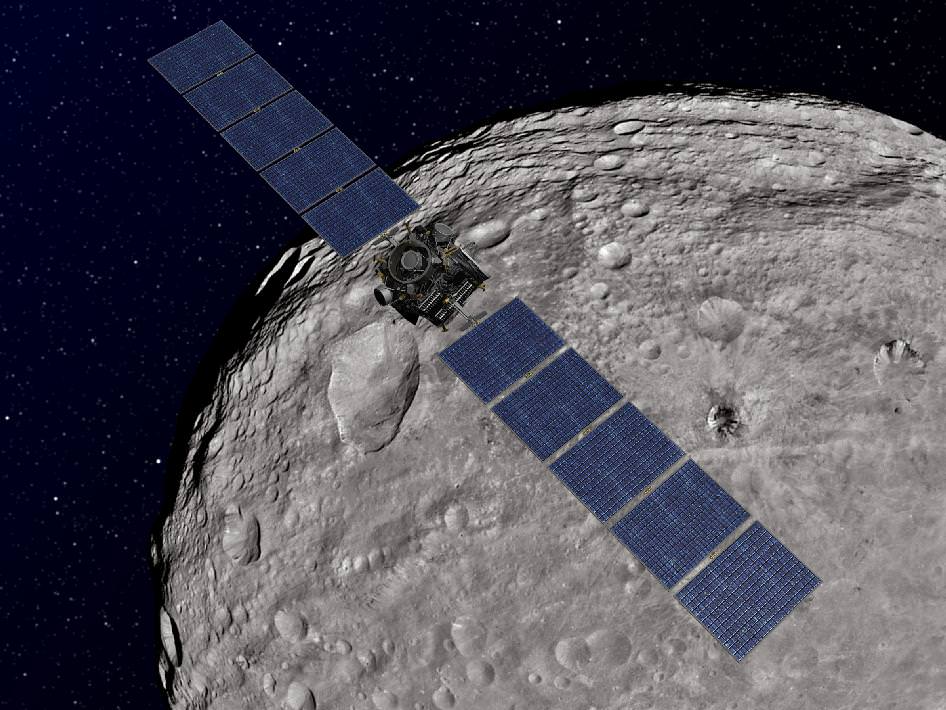
[/caption]
NASA’s Dawn Asteroid Orbiter successfully spiraled down today to the closest orbit the probe will ever achieve around the giant asteroid Vesta, and has now begun critical science observations that will ultimately yield the mission’s highest resolution measurements of this spectacular body.
“What can be more exciting than to explore an alien world that until recently was virtually unknown!” Dr. Marc Rayman gushed in an exclusive interview with Universe Today. Rayman is Dawn’s Chief Engineer from NASA’s Jet Propulsion Lab (JPL) in Pasadena, Calif., and a protégé of Star Trek’s Mr. Scott.
Before Dawn, Vesta was little more than a fuzzy blob in the world’s most powerful telescopes. Vesta is the second most massive object in the main Asteroid Belt between Mars and Jupiter.
Dawn is now circling about Vesta at the lowest planned mapping orbit, dubbed LAMO for Low Altitude Mapping Orbit. The spacecraft is orbiting at an average altitude of barely 130 miles (210 kilometers) above the heavily bombarded and mysterious world that stems from the earliest eons of our solar system some 4.5 Billion years ago. Each orbit takes about 4.3 hours.
“It is both gratifying and exciting that Dawn has been performing so well,” Rayman told me.
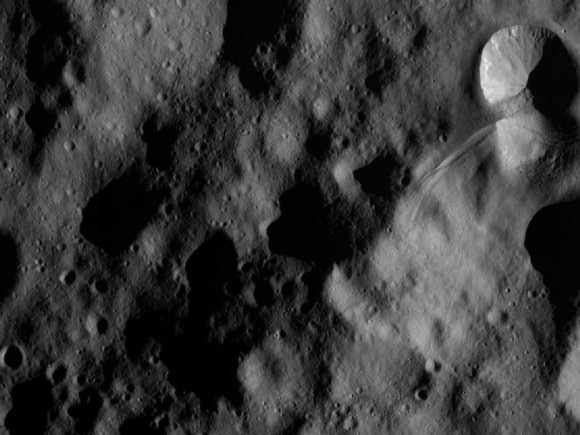
This image of the giant asteroid Vesta was obtained by Dawn in the evening Nov. 27 PST (early morning Nov. 28, UTC), as it was spiraling down from its high altitude mapping orbit to low altitude mapping orbit. Low altitude mapping orbit is the closest orbit Dawn will be making, at an average of 130 miles (210 kilometers) above the giant asteroid's surface. The framing camera obtained this image of an area in the northern mid-latitudes of Vesta from an altitude of about 140 miles (230 kilometers). Credit: NASA/JPL-Caltech/UCLA/MPS/DLR/IDA
Dawn arrived in orbit at Vesta in July 2011 after a nearly 4 year interplanetary cruise since blasting off atop a Delta II rocket from Cape Canaveral, Florida in September 2007. The probe then spent the first few weeks at an initial science survey altitude of about 1,700 miles (2,700 kilometers).
Gradually the spaceship spiraled down closer to Vesta using her ion propulsion thrusters.
See Vesta science orbit diagram, below, provided courtesy of Dr. Marc Rayman.
Along the way, the international science and engineering team commanded Dawn to make an intermediate stop this past Fall 2011 at the High Altitude Mapping orbit altitude (420 miles, or 680 kilometers).
“It is so cool now to have reached this low orbit [LAMO]. We already have a spectacular collection of images and other fascinating data on Vesta, and now we are going to gain even more,” Rayman told me.
“We have a great deal of work ahead to acquire our planned data here, and I’m looking forward to every bit!
Dawn will spend a minimum of 10 weeks acquiring data at the LAMO mapping orbit using all three onboard science instruments, provided by the US, Germany and Italy.
While the framing cameras (FC) from Germany and the Visible and Infrared Mapping spectrometer (VIR) from Italy will continue to gather mountains of data at their best resolution yet, the primary science focus of the LAMO orbit will be to collect data from the gamma ray and neutron detector (GRaND) and the gravity experiment.
GRaND will measure the elemental abundances on the surface of Vesta by studying the energy and neutron by-products that emanate from it as a result of the continuous bombardment of cosmic rays. The best data are obtained at the lowest altitude.
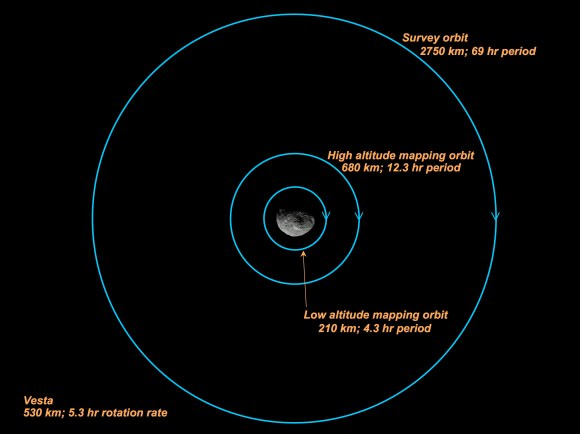
Credit: NASA/JPL-Caltech/Marc Rayman
By examining all the data in context, scientists hope to obtain a better understanding of the formation and evolution of the early solar system.
Vesta is a proto-planet, largely unchanged since its formation, and whose evolution into a larger planet was stopped cold by the massive gravitational influence of the planet Jupiter.
“Dawn’s visit to Vesta has been eye-opening so far, showing us troughs and peaks that telescopes only hinted at,” said Christopher Russell, Dawn’s principal investigator, based at UCLA. “It whets the appetite for a day when human explorers can see the wonders of asteroids for themselves.”
After investigating Vesta for about a year, the engineers will ignite Dawn’s ion propulsion thrusters and blast away to Ceres, the largest asteroid which may harbor water ice and is another potential outpost for extraterrestrial life
Dawn will be the first spaceship to orbit two worlds and is also the first mission to study the asteroid belt in detail.
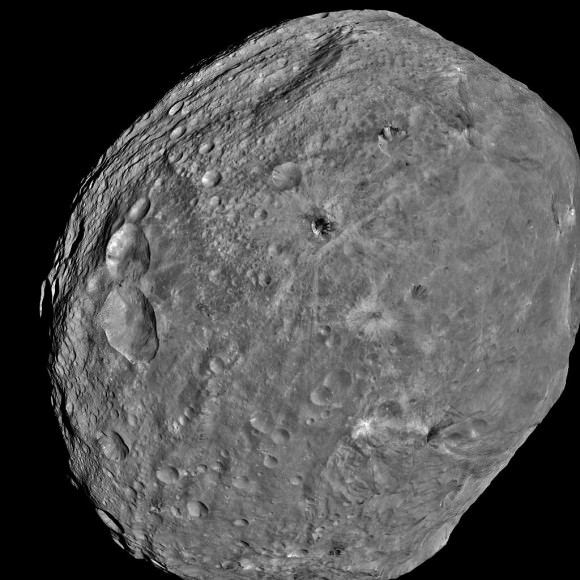
NASA's Dawn spacecraft obtained this image of the giant asteroid Vesta with its framing camera on July 24, 2011. It was taken from a distance of about 3,200 miles (5,200 kilometers). Before Dawn, Vesta was just a fuzzy blob in the most powerful telescopes. Dawn entered orbit around Vesta on July 15, and will spend a year orbiting the body before firing up the ion propulsion system to break orbit and speed to Ceres, the largest Asteroid. Credit: NASA/JPL-Caltech/UCLA/MPS/DLR/IDA

An ancient cosmic collision blasted away much of the south pole of Vesta, leaving behind an enoumous mountain about 3 times the height of Mt. Everest. NASA's Dawn spacecraft obtained this image centered on the south pole of Vesta with its framing camera on July 18, 2011 as it passed the terminator. The image has been enhanced to bring out more surface details. It was taken from a distance of about 6,500 miles (10,500 kilometers) away from the protoplanet Vesta. The smallest detail visible is about 1.2 miles (2.0 km). Credit: NASA/JPL-Caltech/UCLA/MPS/DLR/IDA. Enhanced and annotated by Ken Kremer
Read continuing features about Dawn by Ken Kremer starting here:
Rainbow of Colors Reveal Asteroid Vesta as More Like a Planet
Vrooming over Vivid Vestan Vistas in Vibrant 3 D – Video
NASA Planetary Science Trio Honored as ‘Best of What’s New’ in 2011- Curiosity/Dawn/MESSENGER
Dawn Discovers Surprise 2nd Giant South Pole Impact Basin at Strikingly Dichotomous Vesta
Amazing New View of the Mt. Everest of Vesta
Dramatic 3 D Imagery Showcases Vesta’s Pockmarked, Mountainous and Groovy Terrain
Rheasilvia – Super Mysterious South Pole Basin at Vesta
Space Spectacular — Rotation Movies of Vesta
3 D Alien Snowman Graces Vesta
NASA Unveils Thrilling First Full Frame Images of Vesta from Dawn
Dawn Spirals Down Closer to Vesta’s South Pole Impact Basin
Opportunity Discovers Most Powerful Evidence Yet for Martian Liquid Water
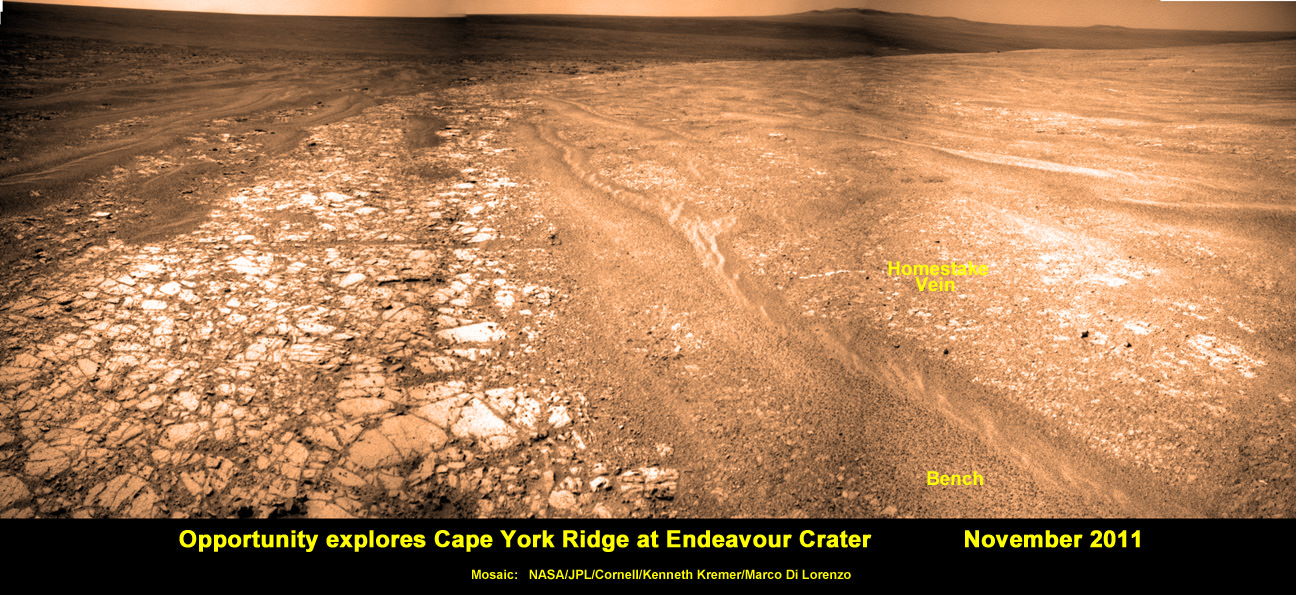
[/caption]
NASA’s long lived Opportunity rover has discovered the most scientifically compelling evidence yet for the flow of liquid water on ancient Mars. The startling revelation comes in the form of a bright vein of the mineral gypsum located at the foothills of an enormous crater named Endeavour, where the intrepid robot is currently traversing. See our mosaic above, illustrating the exact spot.
Update: ‘Homestake’ Opportunity Mosaic above has just been published on Astronomy Picture of the Day (APOD) – 12 Dec 2011 (by Ken Kremer and Marco Di Lorenzo)
Researchers trumpeted the significant water finding this week (Dec. 7) at the annual winter meeting of the American Geophysical Union (AGU) in San Francisco.
“This gypsum vein is the single most powerful piece of evidence for liquid water at Mars that has been discovered by the Opportunity rover,” announced Steve Squyres of Cornell University, Ithaca, N.Y., Principal Investigator for Opportunity, at an AGU press conference.
The light-toned vein is apparently composed of the mineral gypsum and was deposited as a result of precipitation from percolating pools of liquid water which flowed on the surface and subsurface of ancient Mars, billions of years ago. Liquid water is an essential prerequisite for life as we know it.
“This tells a slam-dunk story that water flowed through underground fractures in the rock,” said Squyres. “This stuff is a fairly pure chemical deposit that formed in place right where we see it. That can’t be said for other gypsum seen on Mars or for other water-related minerals Opportunity has found. It’s not uncommon on Earth, but on Mars, it’s the kind of thing that makes geologists jump out of their chairs.”
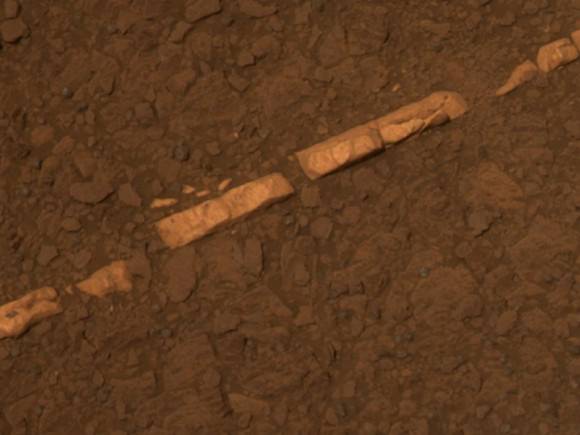
This color view of a mineral vein called "Homestake" was taken by the panoramic camera (Pancam) on NASA's Mars Exploration Rover Opportunity. The vein is about the width of a thumb and about 18 inches (45 centimeters) long. Opportunity examined it in November 2011 and found it to be rich in calcium and sulfur, possibly the calcium-sulfate mineral gypsum.
The light-toned vein is informally named “Homestake”, and was examined up close by Opportunity’s cameras and science instruments for several weeks this past month in November 2011, as the rover was driving northwards along the western edge of a ridge dubbed ‘Cape York’ – which is a low lying segment of the eroded rim of Endeavour Crater.
Veins are a geologic indication of the past flow of liquid water
Opportunity just arrived at the rim of the 14 mile (22 kilometere) wide Endeavour Crater in mid-August 2011 following an epic three year trek across treacherous dune fields from her prior investigative target at the ½ mile wide Victoria Crater.
“It’s like a whole new mission since we arrived at Cape York,” said Squyres.
‘Homestake’ is a very bright linear feature.
“The ‘Homestake’ vein is about 1 centimeter wide and 40 to 50 centimeters long,” Squyres elaborated. “It’s about the width of a human thumb.”
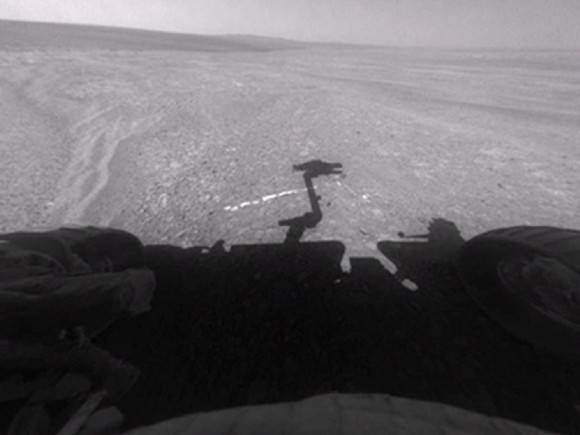
This view from the front hazard-avoidance camera on NASA's Mars Exploration Rover Opportunity shows the rover's arm's shadow falling near a bright mineral vein informally named Homestake. The vein is about the width of a thumb and about 18 inches (45 centimeters) long. Opportunity examined it in November 2011 and found it to be rich in calcium and sulfur, possibly the calcium-sulfate mineral gypsum. Opportunity took this image on Sol 2763 on Mars (Nov. 7, 2011). Credit: NASA/JPL-Caltech
Homestake protrudes slightly above the surrounding ground and bedrock and appears to be part of a system of mineral veins running inside an apron (or Bench) that in turn encircles the entire ridge dubbed Cape York.
In another first, no other veins like these have been seen by Opportunity throughout her entire 20 miles (33 kilometers) and nearly eight year long Martian journey across the cratered, pockmarked plains of Meridiani Planum, said Squyres.
The veins have also not been seen in the higher ground around the rim at Endeavour crater.
“We want to understand why these veins are in the apron but not out on the plains,” said the mission’s deputy principal investigator, Ray Arvidson, of Washington University in St. Louis. “The answer may be that rising groundwater coming from the ancient crust moved through material adjacent to Cape York and deposited gypsum, because this material would be relatively insoluble compared with either magnesium or iron sulfates.”
Opportunity was tasked to engage her Microscopic Imager and Alpha Particle X-ray Spectrometer (APXS) mounted on the terminus of the rover’s arm as well as multiple filters of the mast mounted Panoramic Camera to examine ‘Homestake’.
“The APXS spectrometer shows ’Homestake’ is chock full of Calcium and Sulfur,” Squyres gushed.
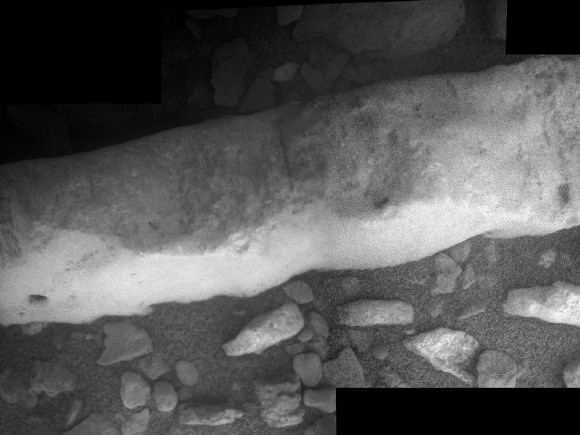
This close-up view of a mineral vein called Homestake comes from the microscopic imager on Opportunity. The vein is about the width of a thumb and about 18 inches (45 centimeters) long. Opportunity examined it in November 2011 and found it to be rich in calcium and sulfur, possibly the calcium-sulfate mineral gypsum. Homestake is near the edge of the "Cape York" segment of the western rim of Endeavour Crater. This view blends three exposures taken by the microscopic imager during the 2,765th and 2,766th Martian days, or sols, of Opportunity's career on Mars (Nov. 3 and 4, 2011). Credit: NASA/JPL-Caltech/Cornell/USGS
The measurements of composition with the APXS show that the ratio points to it being relatively pure calcium sulfate, Squyres explained. “One type of calcium sulfate is gypsum.”
Calcium sulfate can have varying amounts of water bound into the minerals crystal structure.
The rover science team believes that this form of gypsum discovered by Opportunity is the dihydrate; CaSO4•2H2O. On Earth, gypsum is used for making drywall and plaster of Paris.
The gypsum was formed in the exact spot where Opportunity found it – unlike the sulfate minerals previously discovered which were moved around by the wind and other environmental and geologic forces.
“There was a fracture in the rock, water flowed through it, gypsum was precipitated from the water. End of story,” Squyres noted. “There’s no ambiguity about this, and this is what makes it so cool.”
At Homestake we are seeing the evidence of the ground waters that flowed through the ancient Noachian rocks and the precipitation of the gypsum, which is the least soluble of the sulfates, and the other magnesium and iron sulfates which Opportunity has been driving on for the last 8 years.
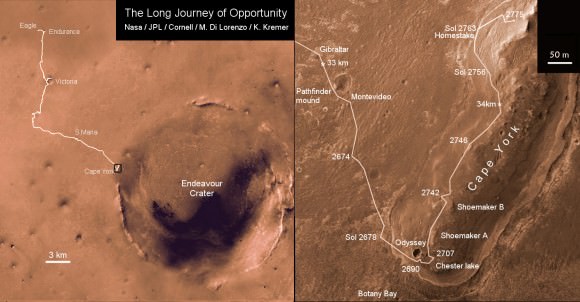
Traverse map showing the 8 Year Journey of Opportunity from Eagle Crater landing site Sol 1 (Jan. 24, 2004) to Sol 2775 (November 2011). Map shows rover location around Homestake water related mineral on Sol 2763 (November 2011) at Cape York ridge at Endeavour Crater rim. Endeavour Crater is 14 miles or 22 kilometers in diameter. Opportunity has driven more than 21 miles (34 km).
Credit: NASA/JPL/Cornell/Marco Di Lorenzo/Kenneth Kremer
“Here, both the chemistry, mineralogy, and the morphology just scream water,” Squyres exclaimed. “This is more solid than anything else that we’ve seen in the whole mission.”
It’s inconceivable that the vein is something else beside gypsum, said Squyres.
As Opportunity drove from the plains of Meridiani onto the rim of Endeavour Crater and Cape York, it crossed a geologic boundary and arrived at a much different and older region of ancient Mars.
The evidence for flowing liquid water at Endeavour crater is even more powerful than the silica deposits found by Spirit around the Home Plate volcanic feature at Gusev Crater a few years ago.
“We will look for more of these veins in the [Martian] springtime,” said Squyres.
If a bigger, fatter vein can be found, then Opportunity will be directed to grind into it with her still well functioning Rock Abrasion Tool, or RAT.
Homestake was crunched with the wheels – driving back and forth over the vein – to break it up and expose the interior. Opportunity did a triple crunch over Homestake, said Arvidson.
Homestake was found near the northern tip of Cape York, while Opportunity was scouting out a “Winter Haven” location to spend the approaching Martian winter.
Arvidson emphasized that the team wants Opportunity to be positioned on a northerly tilted slope to catch the maximum amount of the sun’s rays to keep the rover powered up for continuing science activities throughout the fast approaching Martian winter.
“Martian winter in the southern hemisphere starts on March 29, 2012. But, Solar power levels already begin dropping dramatically months before Martian winter starts,” said Alfonso Herrera to Universe Today, Herrera is a Mars rover mission manager at NASA’s Jet Propulsion Laboratory in Pasadena, Calif.
“Opportunity is in excellent health,” said Bruce Banerdt, the Project Scientist for the Mars rover mission at JPL.
“This has been a very exciting time. We’ll head back south in the springtime and have a whole bunch of things to do with a very capable robot,” Squyres concluded.
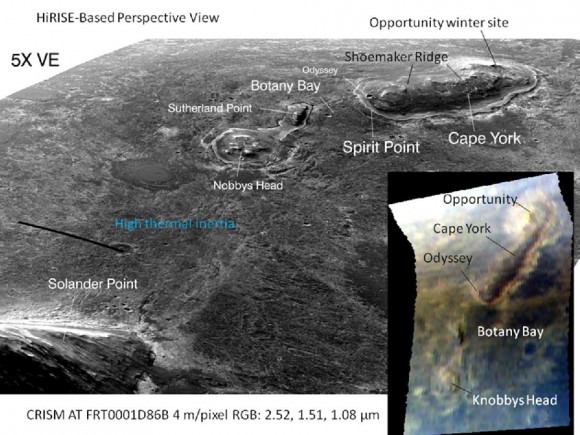
This graphic combines a perspective view of the "Botany Bay" and "Cape York" areas of the rim of Endeavour Crater on Mars, and an inset with mapping-spectrometer data. Major features are labeled. In the perspective view, the landscape's vertical dimension is exaggerated five-fold compared with horizontal dimensions. NASA's Mars Exploration Rover Opportunity examined targets in the Cape York area during the second half of 2011. The perspective view was generated by producing an elevation map from a stereo pair of images from the High Resolution Imaging Science Experiment (HiRISE) camera on NASA's Mars Reconnaissance Orbiter, then draping one of the HiRISE images over the elevation model. The inset presents data from the Compact Reconnaissance Imaging Spectrometer for Mars (CRISM) instrument on the Mars Reconnaissance Orbiter. In this CRISM observation, taken on March 29, 2011 Thermal inertia estimates from observations by the Thermal Emission Imaging System on NASA's Mars Odyssey orbiter indicate that Botany Bay is a region with extensive outcrop exposures. Credit: NASA/JPL-Caltech/UA/JHUAPL
Meanwhile, NASA’s next leap in exploring potential Martian habitats for life – the car sized Curiosity Mars Science Lab rover – is speeding towards the Red Planet.
Read Ken’s continuing features about Opportunity starting here:
NASA Robot seeks Goldmine of Science and Sun at Martian Hill along vast Crater
Opportunity spotted Exploring vast Endeavour Crater from Mars Orbit
Twin Towers 9/11 Tribute by Opportunity Mars Rover
NASA Robot arrives at ‘New’ Landing Site holding Clues to Ancient Water Flow on Mars
Opportunity Arrives at Huge Martian Crater with Superb Science and Scenic Outlook
Opportunity Snaps Gorgeous Vistas nearing the Foothills of Giant Endeavour Crater
Mars Orbiters Will Attempt to Take Pictures of the Curiosity Rover as It Lands
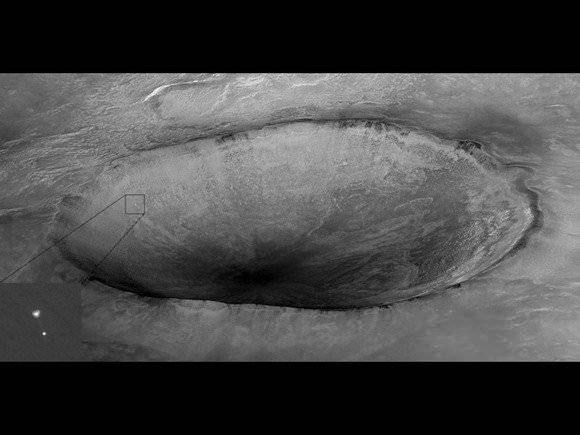
[/caption]
Remember this amazing image from 2008? The HiRISE (High Resolution Imaging Science Experiment) camera on the Mars Reconnaissance Orbiter captured the Phoenix lander descending on a parachute to land on Mars’ north polar region. MRO will attempt a repeat performance in August of 2012 when the Mars Science Laboratory rover “Curiosity” will be landing in Gale Crater on Mars. Capturing this event would be epic, especially with MSL’s unique “skycrane” landing system.
“Yes, MRO is planning to image the descent of MSL with both HiRISE and CTX (Context Camera),” Alfred McEwen, HiRISE principal investigator told Universe Today. “For Phoenix we got a bit lucky with HiRISE in terms of the geometry, giving us a high probability of success. It may not work out so well for MSL. What I’d really like is to capture the rover hanging from the skycrane, but the timing may be difficult.”
Again, the word here is epic.
So, how challenging is it for a spacecraft orbiting Mars to try and track another spacecraft coming in?
“If we were not to do anything, the Mars’ orbiting spacecraft may be on the other side of the planet,” said MSL navigation team chief Tomas Martin-Mur, during an interview with UT. “So as soon as we launch, we tell the other spacecraft where we are going to be by the time of entry so they can change their orbits over time, so they will be flying overhead as MSL approaches the planet.”
The orbiters – which also includes NASA’s Mars Odyssey and ESA’s Mars Express – will have to do special maneuvers to be aligned in just the right place – nearby to MSL’s point of entry into Mars’ atmosphere — and they may even have to change the plane of their orbit.

“The other thing that we’ll need them to do is to point their UHF antennas towards MSL,” Martin-Mur said. “Normally their antennas will be pointed to take pictures, but they will have to go to a special attitude to point to MSL. This will enable them to try — like they did with Phoenix — to take a picture of the spacecraft as it is coming down to the planet. We are hoping to see the parachute deployed and maybe more.”
“That was a great picture for Phoenix, and we will attempt to repeat that,” Martin-Mur added.
While Odyssey and Mars Express’ cameras may not have the resolving power to capture such an image, MRO’s powerful HiRISE camera does. However it has a narrower field of view, so as much skill and planning as this requires, the team will need a little luck, too. But there’s also the CTX.
“CTX has a much larger field of view and will likely capture it,” McEwen said, “but at 20X lower resolution than HiRISE, which should still be good enough to detect the parachute.”
Here’s a preview of what MSL will be going through during the perilous entry descent and landing:
Learn more about the navigation for MSL, currently traveling on its way to Mars, in our previous interview with Tomas Martin-Mur.
Are Gas-Formed Gullies the Norm on Mars?
[/caption]
In June 2000, Martian imaging scientists made a striking discovery — data from NASA’s Mars Global Surveyor spacecraft found gullies on the red planet. Gullies on Earth form when water runs down steep slopes and carves soil out of its way, so the discovery of this geologic feature on Mars was enticing evidence that liquid water existed on or near the surface of Mars.
But gullies have also been spotted in the Mars’ polar regions where the temperature is too cold for water to exist in its liquid form. Adding to the puzzle is the suggestion that the apparent gullies are actually formed by wind or underground gases causing sand and dust to roll down a steep hill and create what looks like a gully formed by Water. So what’s behind the gullies at Mars’ poles?

Frozen carbon dioxide — more commonly known as dry ice — isn’t an uncommon feature on Mars. It can freeze out of the carbon dioxide rich atmosphere on Mars and, after a dust storm, be covered by a thin layer of dust or sand. Recently, researchers are looking to this subsurface dry ice as a possible explanation for Martian gullies, particularly at the frozen poles.
The key here is sublimation — the phenomenon of a solid passing directly into its gaseous state. You’ve seen this happen if you’ve ever poured water on dry ice. The water warms the solid dry ice and turn it into a gas. On Mars, it’s possible that changes in temperatures with seasons could be enough to sublimate the frozen carbon dioxide. The expulsion of the gas through the soil on the surface could cause it to roll down a hill like a fluid. The same thing would happen with water coming up from under ground.
Whether or not dry ice sublimation is behind polar gullies became a focus of Yolanda Cedillo-Flores and three colleagues at the Lunar and Planetary Institute in Houston, Texas.
A previous study testing whether sublimating dry ice could form gullies, led by Cedillo-Flores, was brilliant in its simplicity. They piled sand into Mars-like slopes then blew air underneath the sand. The sand flowed down the slope, much like a liquid would, and formed was looked very much like a gully.
Recently, the team at the Lunar and Planetary Institute have been testing the possibility of this phenomenon happening on Mars. They used the average daytime and seasonal temperatures of the Martian year to calculate the sublimation rate of dry ice on Mars. Then, they ran models of this event on Martian areas without any sediment as well as those with layers of sand and dust of varying thickness over the average seasonal deposit of dry ice. When simulated spring came, enough heat reached the dry ice that it sublimated and acted like a fluid. Turns out, Mars is just right for seasonal sublimation of frozen carbon dioxide.
They finally came to the conclusion that carbon dioxide sublimation is the likeliest cause behind the gullies forming in Mars’ polar regions.
Sources: Martian gullies: Produced by fluidization of dry material, CO2 gas fluidization in the initiation and formation of Martian polar gullies.

Flawlessly On Course Curiosity Cruising to Mars – No Burn Needed Now
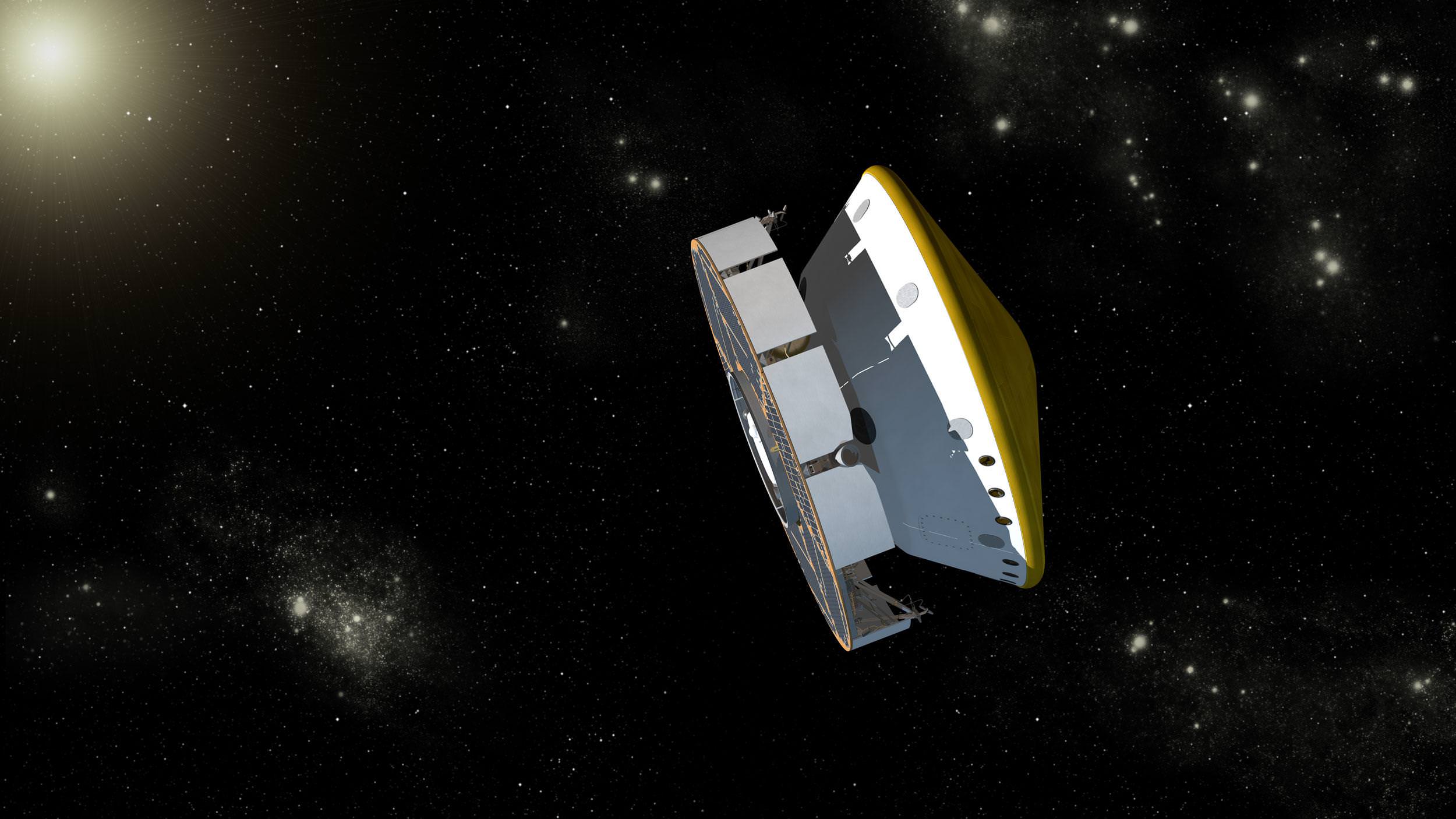
[/caption]
Curiosity’s interplanetary injection was spot on ! – following her Nov. 26 blastoff aboard the 2 million pound thrust Atlas V booster from Cape Canaveral in Florida.
For a birds-eye view of where it all started, watch the cool close-up launch video, below taken from within the Atlas pad security fence.
Indeed the launch precision was so good that mission controllers at NASA’s Jet Propulsion Lab in Pasadsena, Calif., have announced they postponed the first of six planned course correction burns for the agency’s newest Mars rover by at least a month. The firing had been planned for some two weeks after liftoff.
Curiosity is merrily sailing on a 254 day and 352-million-mile (567-million-kilometer) interplanetary flight from the Earth to Mars that will culminate on August 6, 2012 with a dramatic first-of-its-kind precision rocket powered touchdown inside Gale Crater.
“This was among the most accurate interplanetary injections ever,” said Louis D’Amario of NASA’s Jet Propulsion Laboratory, Pasadena, Calif. He is the mission design and navigation manager for the Mars Science Laboratory.
Video Caption: View from inside the Pad 41 Security Fence at Cape Canaveral. Shot by a Canon 7D still camera during the launch of the Atlas V rocket carrying the MSL Curiosity rover to Mars. Thanks to a sound trigger my camera started firing at three frames per second from just after main engine ignition up until the exhaust plume finally envelops the camera and deadens all sound around it. The frames have been slowed down quite a bit for dramatic effect. Enjoy seeing what it is like for us media personnel who set out our remote cameras for launches at Kennedy Space Center and Cape Canaveral, Florida. Credit: Chase Clark/shuttlephotos.com
As of midday Friday, Dec. 2, the spacecraft had already traveled 10.8 million miles (17.3 million kilometers) and is moving at 7,500 mph (12,000 kilometers per hour) relative to Earth and at 73,800 mph (118,700 kilometers per hour) relative to the sun.
An interesting fact is that engineers deliberately planned the spacecraft’s initial trajectory to miss Mars by about 35,000 miles (56,400 kilometers) so that the Centaur upper stage does not hit Mars by accident. Both Centaur and Curiosity are currently following the same trajectory through the vast void of space and the actual trajectory puts them on course to miss Mars by about 38,000 miles (61,200 kilometers).
The Centaur has not been thoroughly cleaned of earthly microbes in the same way as Curiosity – and therefore cannot be permitted to impact the Martian surface and potentially contaminate the very studies Curiosity seeks to carry out in searching for the “Signs of Life”.
For the 8.5 month voyage to Mars, Curiosity and the rocket powered descent stage are tucked inside an aeroshell and are attached to the huge solar powered cruise stage.
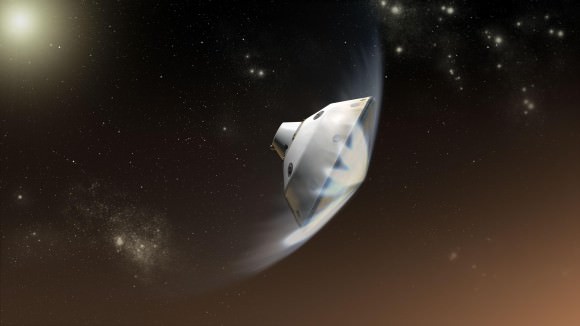
Artist's Concept depicts the interaction of NASA's Mars Science Laboratory spacecraft with the upper atmosphere of Mars during the entry, descent and landing (EDL) of the Curiosity rover onto the Martian surface. EDL begins when the spacecraft reaches the top of Martian atmosphere, about 81 miles (131 kilometers) above the surface of the Gale crater landing area, and ends with the rover safe and sound on the surface of Mars some 7 minutes later. During EDL, the spacecraft decelerates from a velocity of about 13,200 miles per hour (5,900 meters per second) at the top of the atmosphere, to stationary on the surface. Credit: NASA/JPL-Caltech
The cruise stage is rotating at 2.05 rounds per minutes and is continuously generating electric power – currently about 800 watts – from the gleaming solar arrays. It also houses eight miniature hydrazine fueled thrusters. The propellant is stored inside titanium tanks.
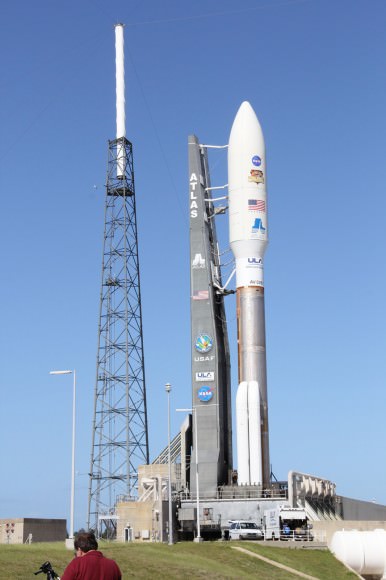
The historic voyage of the largest and most sophisticated Martian rover ever built by humans seeks to determine if Mars ever offered conditions favorable for the genesis of microbial life.
Curiosity is packed to the gills with 10 state of the art science instruments that are seeking to detect the signs of life in the form of organic molecules – the carbon based building blocks of life as we know it.
The car sized robot is equipped with a drill and scoop at the end of its 7 ft long robotic arm to gather soil and powdered samples of rock interiors, then sieve and parcel out these samples into two distinct analytical laboratory instruments inside the rover.
Complete Coverage of Curiosity – NASA’s Next Mars Rover launched 26 Nov. 2011
Read continuing features about Curiosity by Ken Kremer starting here:
NASA Planetary Science Trio Honored as ‘Best of What’s New’ in 2011- Curiosity/Dawn/MESSENGER
Curiosity Mars Rover Launch Gallery – Photos and Videos
Curiosity Majestically Blasts off on ‘Mars Trek’ to ascertain ‘Are We Alone?
Mars Trek – Curiosity Poised to Search for Signs of Life
Curiosity Rover ‘Locked and Loaded’ for Quantum Leap in Pursuit of Martian Microbial Life
Science Rich Gale Crater and NASA’s Curiosity Mars Rover in Glorious 3-D – Touchdown in a Habitable Zone
Curiosity Powered Up for Martian Voyage on Nov. 26 – Exclusive Message from Chief Engineer Rob Manning
NASA’s Curiosity Set to Search for Signs of Martian Life
Curiosity Rover Bolted to Atlas Rocket – In Search of Martian Microbial Habitats
Closing the Clamshell on a Martian Curiosity
Curiosity Buttoned Up for Martian Voyage in Search of Life’s Ingredients
Assembling Curiosity’s Rocket to Mars
Encapsulating Curiosity for Martian Flight Test
Dramatic New NASA Animation Depicts Next Mars Rover in Action
Microscopic Worms May Help to Colonize Mars
[/caption]
Once the realm of science fiction, the prospect of colonizing other planets is getting closer to reality. The most logical first place, besides the Moon, has always been Mars. Venus is a bit closer, but the scorching conditions there are, well, much less than ideal. There is still technology that needs to be developed before we can send humans to Mars at all, never mind stay there permanently. But now there may be help from an unlikely and lowly companion. – worms.
Ok, not the kind of worms you find in your garden, but tiny microscopic worms called Caenorhabditis elegans (C. elegans). Similar biologically to humans in some ways, they are being studied by scientists at the University of Nottingham in the UK to help see how people are affected by long-duration space travel.
In December 2006, 4,000 of them were sent into orbit aboard the Space Shuttle Discovery. This was followed by another mission in 2009. The scientists found that in space, the worms develop and produce progeny just as they do on Earth. The research has been published in the November 30, 2011 issue of Interface, a journal of The Royal Society.
According to Dr. Nathaniel Szewczyk of the Division of Clinical Physiology in the School of Graduate Entry Medicine, “While it may seem surprising, many of the biological changes that happen during spaceflight affect astronauts and worms and in the same way. We have been able to show that worms can grow and reproduce in space for long enough to reach another planet and that we can remotely monitor their health. As a result C. elegans is a cost-effective option for discovering and studying the biological effects of deep space missions. Ultimately, we are now in a position to be able to remotely grow and study an animal on another planet.”
He added: “Worms allow us to detect changes in growth, development, reproduction and behaviour in response to environmental conditions such as toxins or in response to deep space missions. Given the high failure rate of Mars missions use of worms allows us to safely and relatively cheaply test spacecraft systems prior to manned missions.”
So while a manned space mission to Mars is still a ways off, some lucky worms may get there first, making the voyage of a lifetime, even if they don’t realize it!
Curiosity Mars Rover Launch Gallery – Photos and Videos
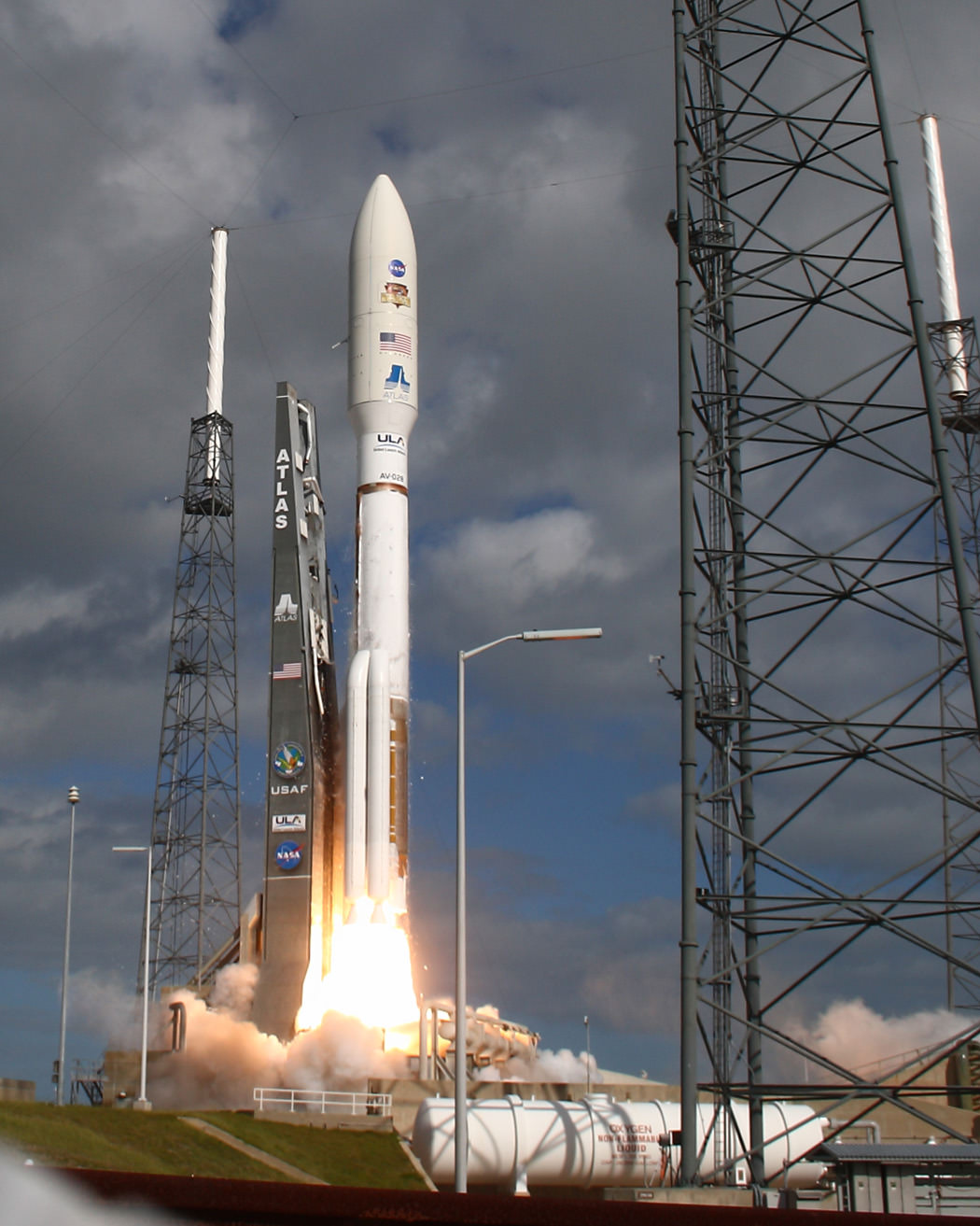
[/caption]
NASA’s Curiosity Mars Science Lab (MSL) rover is speeding away from Earth on a 352-million-mile (567-million-kilometer) journey to Mars following a gorgeous liftoff from Cape Canaveral Air Force Station, Florida aboard a United Launch Alliance Atlas V rocket at 10:02 a.m. EST on Nov. 26.
Enjoy the gallery of Curiosity launch images collected here from the Universe Today team and local photographers as well as NASA and United Launch Alliance.
The historic voyage of the largest and most sophisticated Martian rover ever built by humans seeks to determine if Mars ever offered conditions favorable for the genesis of microbial life.
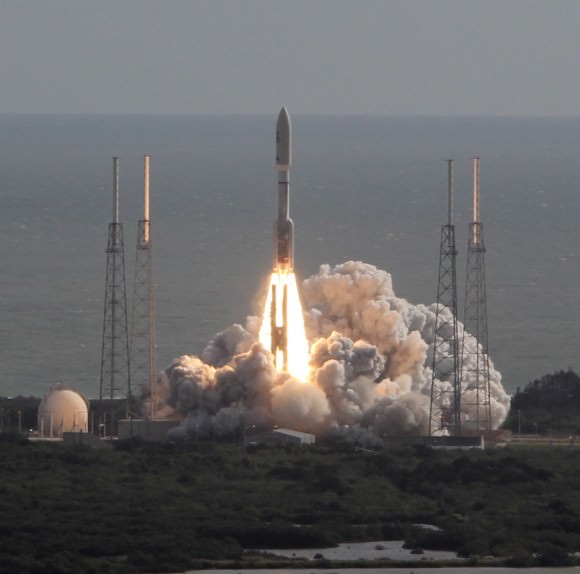
“We are very excited about sending the world’s most advanced scientific laboratory to Mars,” NASA Administrator Charles Bolden said. “MSL will tell us critical things we need to know about Mars, and while it advances science, we’ll be working on the capabilities for a human mission to the Red Planet and to other destinations where we’ve never been.”
The mission will pioneer a first of its kind precision landing technology and a sky- crane touchdown to deliver the car sized rover to the foothills of a towering and layered mountain inside Gale Crater on Aug. 6, 2012.
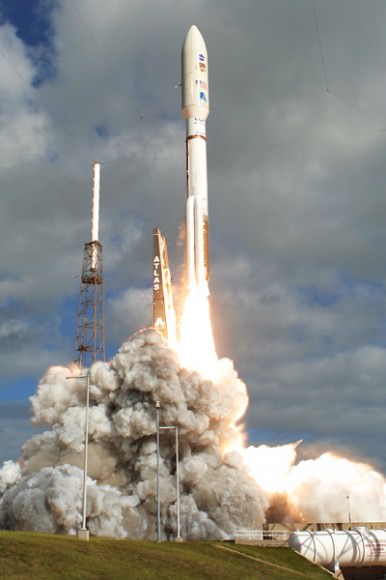
Curiosity is packed to the gills with 10 state of the art science instruments that are seeking the signs of life in the form of organic molecules – the carbon based building blocks of life as we know it.
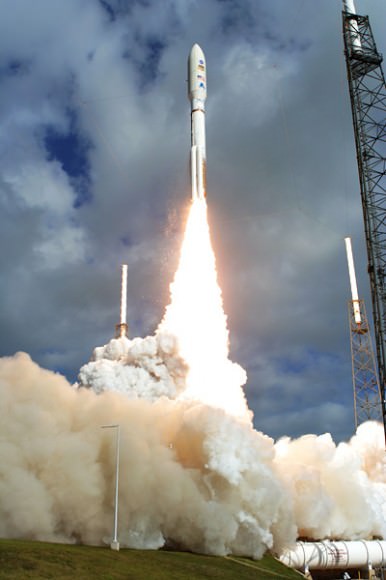
The robot is equipped with a drill and scoop at the end of its robotic arm to gather soil and powdered samples of rock interiors, then sieve and parcel out these samples into analytical laboratory instruments inside the rover.
The 1 ton Curiosity rover sports a science payload that’s 15 times heavier than NASA’s previous set of rovers – Spirit and Opportunity – which landed on Mars in 2004. Some of the tools are the first of their kind on Mars, such as a laser-firing instrument for checking the elemental composition of rocks from a distance, and an X-ray diffraction instrument for definitive identification of minerals in powdered samples.
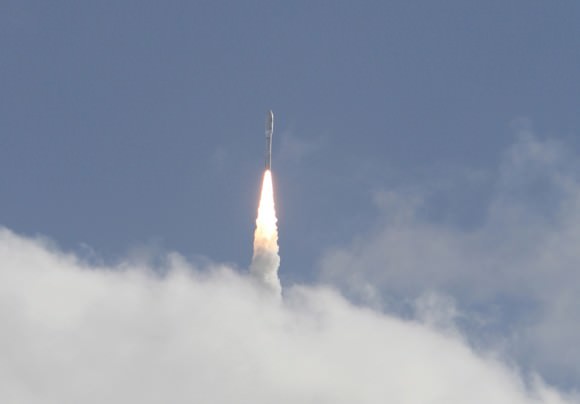
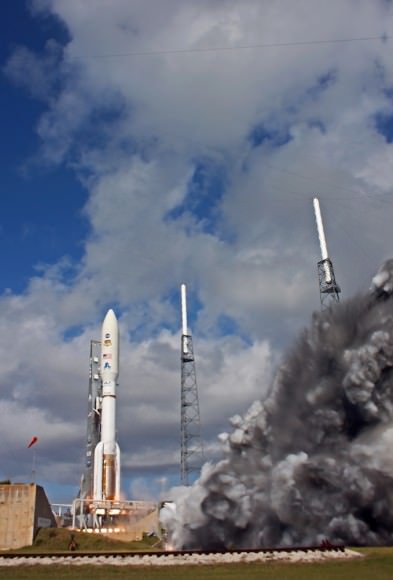
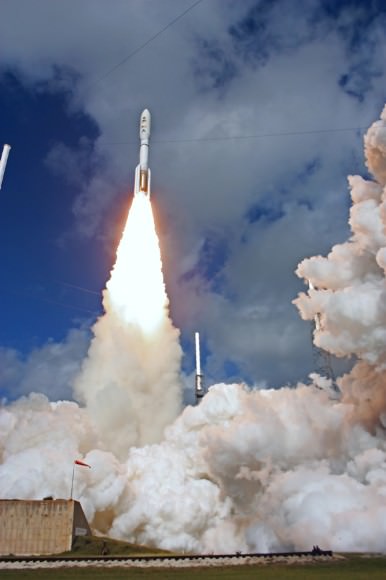
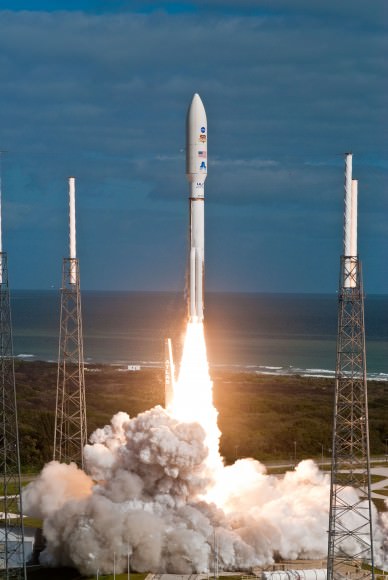
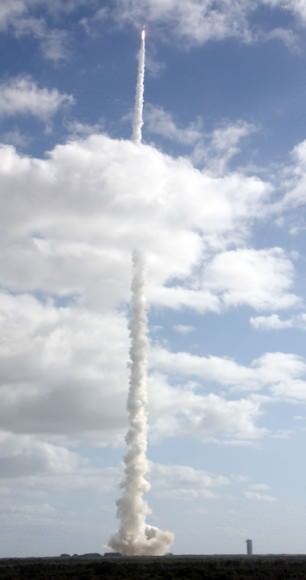
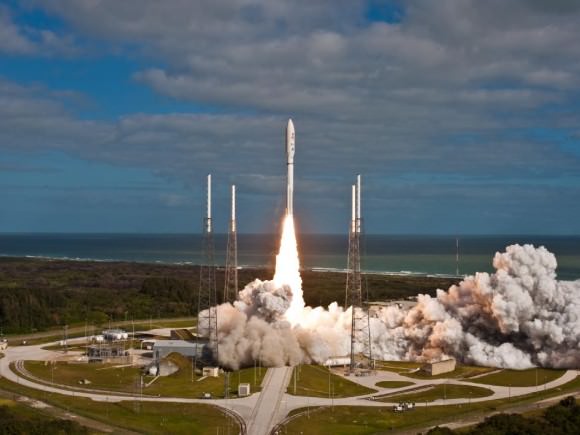
Launch Video – Credit: Matthew Travis/Spacearium
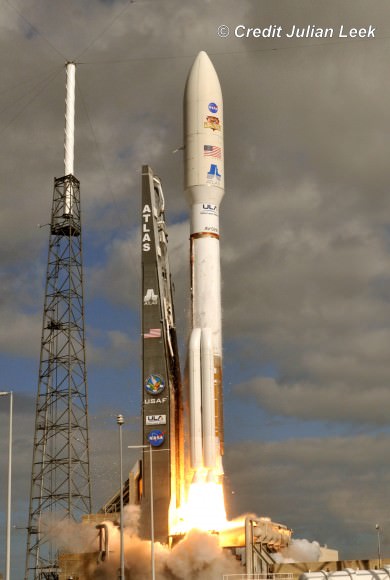
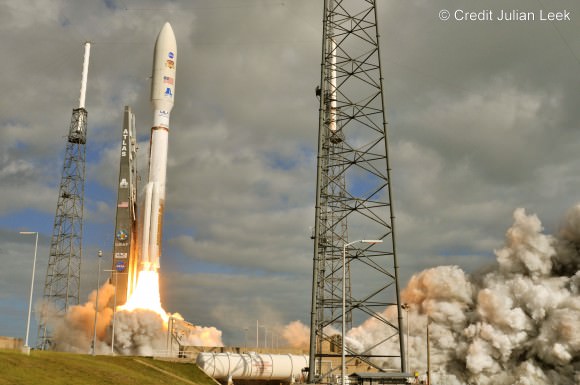
Complete Coverage of Curiosity – NASA’s Next Mars Rover launched 26 Nov. 2011
Read continuing features about Curiosity by Ken Kremer starting here:
Curiosity Majestically Blasts off on ‘Mars Trek’ to ascertain ‘Are We Alone?
Mars Trek – Curiosity Poised to Search for Signs of Life
Curiosity Rover ‘Locked and Loaded’ for Quantum Leap in Pursuit of Martian Microbial Life
Science Rich Gale Crater and NASA’s Curiosity Mars Rover in Glorious 3-D – Touchdown in a Habitable Zone
Curiosity Powered Up for Martian Voyage on Nov. 26 – Exclusive Message from Chief Engineer Rob Manning
NASA’s Curiosity Set to Search for Signs of Martian Life
Curiosity Rover Bolted to Atlas Rocket – In Search of Martian Microbial Habitats
Closing the Clamshell on a Martian Curiosity
Curiosity Buttoned Up for Martian Voyage in Search of Life’s Ingredients
Assembling Curiosity’s Rocket to Mars
Encapsulating Curiosity for Martian Flight Test
Dramatic New NASA Animation Depicts Next Mars Rover in Action
Packing a Mars Rover for the Trip to Florida; Time Lapse Video
Test Roving NASA’s Curiosity on Earth


